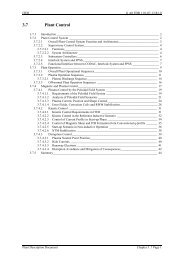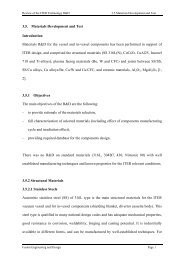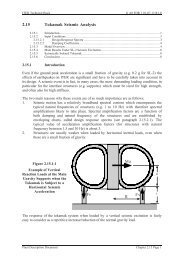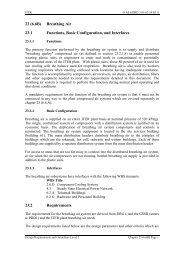3.1 Tritium Plant and Detritiation - General Atomics Fusion Group
3.1 Tritium Plant and Detritiation - General Atomics Fusion Group
3.1 Tritium Plant and Detritiation - General Atomics Fusion Group
- No tags were found...
You also want an ePaper? Increase the reach of your titles
YUMPU automatically turns print PDFs into web optimized ePapers that Google loves.
ITER G A0 FDR 1 01-07-13 R1.0(b) Molecular sieve dryer regeneration loop composed of regeneration gas heater (EH-2),dryer bed cross-over valve headers, one-stage condenser (CX-2), mist separator (Mis-2),filter (F-2) <strong>and</strong> blower battery (BL2-A/B). Tritiated water produced in the recombinerloops <strong>and</strong>/or included in the source gas/air is adsorbed by the dryer bed. When thedecontamination factor (DF) defined by the tritium concentration ratio between inlet <strong>and</strong>outlet streams around the dryer is > 100 (design value 10 2 – 10 4 ), the saturated dryer bedis then switched to the regeneration mode.(c) Direct condensing loop composed of a one-stage condenser (CX-3) <strong>and</strong> mist separator(Mist-3). In case humidity in the source gas/air is very high or saturated, this bypass loopis started for direct condensing of the moisture, <strong>and</strong> the recombiner loop is isolated untilthe room moisture level is reduced to an acceptable level for the st<strong>and</strong>by atmospheredetritiation system dryer bed battery capacity.The use of the direct condensing loop is an important design feature which results in a largereduction of water load on the molecular sieve dryer regeneration loop.All atmosphere detritiation systems utilise proven technology <strong>and</strong> components such ascanned type blowers, recuperative gas/gas heat exchangers, gas/water heat exchangers,electrical gas heaters, catalytic recombiners <strong>and</strong> molecular sieve dryer beds.The design value of the detritiation factor of these atmosphere detritiation systems (glove boxatmosphere detritiation system > 10 2 ; st<strong>and</strong>by atmosphere detritiation system > 10 3 ; normalvent detritiation system, st<strong>and</strong>by vent detritiation system > 10 4 ) has been well proven in theexisting tritium facilities, <strong>and</strong> no further R&D is required.Common Dryer Regeneration SystemIt is expected that the usage of dryer regeneration systems, which is required for allatmosphere detritiation systems, will be very low for the st<strong>and</strong>by detritiation systems (S-VDS, S-ADS). To maximize the effective usage of the dryer regeneration system, a commondryer regeneration system was employed for ITER instead of a distributed regenerationsystem in each detritiation system. A similar design (use of common regeneration system)was applied to the atmosphere detritiation systems located in the hot cell building.Water <strong>Detritiation</strong> SystemThe water detritiation system selected for ITER is based on the existing plant technologyusing catalytic exchange towers <strong>and</strong> electrolysers, which has been operated over 13 years in aJapanese fission reactor. The advantages of the plant technology are compact size due to itsvery high separation efficiency, no production of tritium-bearing waste water due to acomplete decomposition of the water into molecular hydrogen <strong>and</strong> oxygen, <strong>and</strong> operationflexibility over a wide range of tritium concentration (1 mCi/kg – 500 Ci/kg) by thecombination of a tritium-scavenging catalytic exchange process with tritiated waterelectrolysis. The long-term operation of the existing plant has indicated that tritium levels inthe exhaust hydrogen stream can be directly rejected to the environment with suitable airdilution to meet the deflagration limit (1 vol% in air).<strong>Plant</strong> Description Document Chapter <strong>3.1</strong> Page 29








